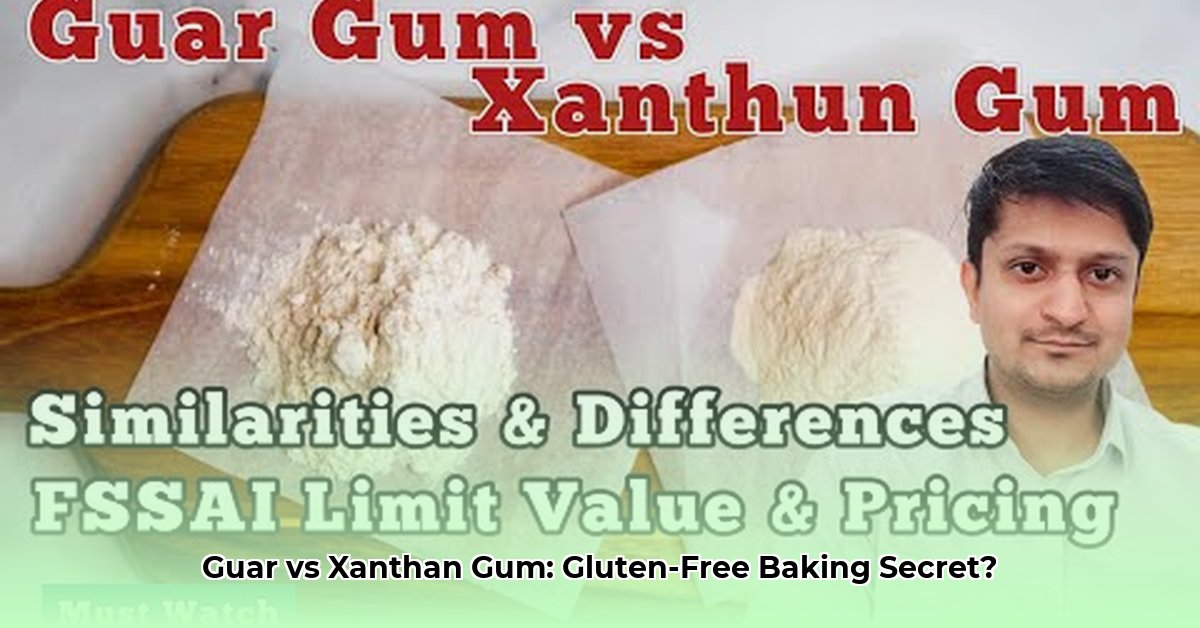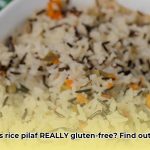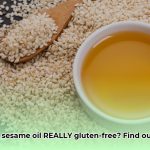Making delicious gluten-free baked goods often hinges on achieving the right texture. Guar gum and xanthan gum are key ingredients that act as binders, helping to replicate the role of gluten. This guide provides an in-depth comparison of these two ingredients, offering practical advice for using them to create perfect gluten-free treats.
Guar Gum and Xanthan Gum: A Head-to-Head Comparison for Gluten-Free Baking Success
Venturing into gluten-free baking introduces unfamiliar ingredients. Guar gum and xanthan gum might sound like lab creations, but they are essential for successful gluten-free recipes. Understanding their differences is vital for achieving desired results in baking.
Understanding the Basics: The Role of Hydrocolloids in Gluten-Free Recipes
Guar gum and xanthan gum are hydrocolloids, thickening agents that provide structure and texture to gluten-free baked goods. Without them, many gluten-free recipes would crumble. They act as the “glue” that holds everything together. Hydrocolloids are water-loving substances that form a gel-like network in baked goods, trapping moisture and preventing the ingredients from separating or collapsing.
Guar gum is derived from guar beans, a legume known for its high water-absorbing properties. The beans are milled into a fine powder. Xanthan gum is created through bacterial fermentation, a process where a specific bacteria consumes sugars and excretes a gummy substance, similar to how yogurt is made. These different sources result in unique chemical structures, impacting their baking properties.
Xanthan Gum vs. Guar Gum: Key Feature Breakdown
The main differences between guar gum and xanthan gum are highlighted below:
| Feature | Guar Gum | Xanthan Gum |
|---|---|---|
| Source | Guar beans | Bacterial fermentation |
| Texture | Creates a slightly gummy, more viscous texture | Provides a more elastic, less sticky texture |
| Water Absorption | Absorbs a LOT of water | Absorbs less water |
| Heat Stability | Can be slightly affected by high heat | Very stable, even under high heat |
| Cost | Generally less expensive | Generally more expensive |
| Emulsification | Excellent emulsifier (blends liquids well) | Good emulsifier |
| Gluten Mimicry | Less effective at mimicking gluten | More effective at mimicking gluten |
| Flavor | Can impart a slight beany flavor | Generally flavorless |
Choosing the Right Gum for Your Recipe: A Guide to Gluten-Free Ingredient Selection
The “best” gum depends on the specific baking application and the desired texture.
- For chewy, springy bread: Xanthan gum is preferred because it mimics the stretchy properties of gluten, resulting in a more robust crumb.
- For smooth sauces or creamy dressings: Guar gum is ideal because its emulsification properties create stable sauces that don’t separate.
- For budget-conscious baking: Guar gum is typically more affordable.
- For delicate cookies or cakes: A blend of both gums may yield optimal texture.
Start with a small amount (about a teaspoon or less) and adjust as needed. Many recipes will specify which gum to use, but experimentation is key to finding what works best for your personal preference.
Practical Tips and Troubleshooting for Baking with Guar and Xanthan Gum
To avoid common baking problems related to gums:
- Avoid Xanthan Gum Overload: Using too much xanthan gum can lead to gummy baked goods. Start with about ¼ teaspoon per cup of gluten-free flour blend.
- Prevent Guar Gum Clumps: Whisk guar gum with a dry ingredient before adding it to wet ingredients or add it slowly while actively mixing to ensure even distribution.
- Experiment with Combinations: Try different ratios of guar gum and xanthan gum to find your preferred combinations for different types of baked goods.
- Consider Specific Flour Blends: Different gluten-free flour blends may already contain gums, so adjust accordingly to avoid overpowering the recipe.
- Account for Altitude: At higher altitudes, you may need to reduce the amount of gum to prevent dryness.
Beyond the Basics: Exploring Synergistic Effects of Guar Gum and Xanthan Gum in Gluten-Free Baking
Many gluten-free bakers combine guar gum and xanthan gum. This combination leverages their individual strengths, creating a synergistic effect that improves the overall texture and structure of baked goods. For example, combining both gums can improve crumb structure and moisture retention, resulting in a more tender and palatable final product.
The ideal ratio of guar gum to xanthan gum often depends on the specific recipe. A 1:1 ratio is a good starting point, but you may need to adjust based on the ingredients and desired outcome.
Potential Downsides and Considerations
While generally safe, some individuals may experience digestive discomfort from consuming large amounts of either guar gum or xanthan gum. It’s always a good idea to start with small amounts and monitor your body’s reaction.
Additionally, xanthan gum is often derived from corn, soy, or wheat. If you have allergies to these ingredients, be sure to choose a xanthan gum that is derived from an alternative source, such as tapioca or sugar beet.
The Bottom Line: Maximizing Your Gluten-Free Baking with the Right Gum
Choosing between guar gum and xanthan gum involves understanding their unique properties and considering the specific requirements of your recipe. Experiment, learn, and enjoy creating delicious gluten-free masterpieces. With a little practice, you’ll be able to confidently navigate the world of gluten-free baking and create treats that are both delicious and satisfying.
How to Choose Between Guar Gum and Xanthan Gum for Gluten-Free Baking Recipes
Finding the right binders is crucial for gluten-free baking. Let’s explore which gum is the best choice for your recipes.
Understanding the Players: Xantham Gum vs. Guar Gum
Both gums are hydrocolloids, acting as thickening and stabilizing agents, or “glue,” in gluten-free batters, but they have distinct characteristics. Guar gum, derived from guar beans, creates a smooth, creamy texture, while xanthan gum, a fermented corn product, provides elasticity and structure.
Key Differences: A Head-to-Head Comparison
| Feature | Guar Gum | Xanthan Gum |
|---|---|---|
| Source | Guar beans | Fermented corn |
| Texture | Smooth, creamy | Elastic, slightly sticky |
| Binding Power | Good, especially in emulsions | Excellent, better for structure |
| Acid Sensitivity | Sensitive; loses thickening power at low pH | Less sensitive to acidity |
| Cost | Generally less expensive | More expensive |
| Potential Issues | Beany flavor possible; can cause digestive upset in some | Possible slightly chemical aftertaste |
| Best For | Creamy fillings, sauces, and custards | Breads, pizza dough, and pastries |
Choosing the Right Gum: Selecting the Best Option for Your Recipes
The ideal gum choice depends on the recipe.
- For breads and items needing structure: Xanthan gum is superior due to its elasticity, which mimics gluten and provides lift and chewiness.
- For cakes, muffins, and cookies needing smooth texture and emulsification: Guar gum works best, preventing dryness and creating moist results.
- For recipes with acidic ingredients (like lemon juice): Xanthan gum is preferred due to its acid stability.
- For many recipes: A combination of both gums can offer the best of both worlds.
Working with Guar and Xanthan Gums: Tips for Success
- Start small: Begin with small amounts of gum, increasing gradually to achieve the desired consistency.
- Measure accurately: Use a kitchen scale for precise measurements for consistent results.
- Proper dispersion: Whisk the gum into a small amount of liquid or with dry ingredients before adding it to the batter to prevent clumping.
- Acid Consideration: Guar gum is sensitive to acidity, while xanthan gum holds up better. Therefore, add guar gum towards the end of the recipe if it contains acidic ingredients.
Key Takeaways:
- Guar gum and xanthan gum have distinct properties.
- Each gum contributes unique textures to gluten-free baking.
- Recipe types guide gum selection.
- Combining gums may offer optimal results.
- Precise measuring and proper dispersion are vital.
Guar Gum and Xanthan Gum Synergies in Gluten-Free Bread Making
Combining guar gum and xanthan gum often results in superior textures and structures compared to using either gum alone because the resulting bread offers a better crumb and improved moisture retention. This approach can result in a more tender crumb and reduce the risk of unpleasant textures that can occur when using too much of a single gum.
Key Takeaways:
- Both gums are essential for gluten-free baking, mimicking gluten’s binding properties.
- Xanthan gum provides elasticity and a neutral taste, while guar gum offers thickening and emulsification but may impart a beany flavor.
- Using both gums together results in superior texture and structure.
- Careful measurement is crucial because too much can create gummy textures.
- Consider potential allergies and digestive sensitivities.
- Experiment to find the best gum combination for your desired outcome.
Understanding the
- Affordable Employee Wellness Fair Ideas for Any Budget - December 14, 2025
- Employee Wellness Programs Strategically Benefit Employee Health And Retention - December 13, 2025
- Health and Wellbeing Companies Driving Employee Engagement and Productivity - December 13, 2025
















